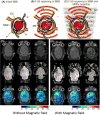Image-guided drug delivery to the brain using nanotechnology
- PMID: 23817076
- PMCID: PMC4186772
- DOI: 10.1016/j.drudis.2013.06.010
Image-guided drug delivery to the brain using nanotechnology
Abstract
Targeting across the blood-brain barrier (BBB) for treatment of central nervous system (CNS) diseases represents the most challenging aspect of, as well as one of the largest growing fields in, neuropharmaceutics. Combining nanotechnology with multiple imaging techniques has a unique role in the diagnosis and treatment (theranostics) of CNS disease. Such imaging techniques include anatomical imaging modalities, such as magnetic resonance imaging (MRI), ultrasound (US), X-ray computed tomography (CT), positron emission tomography (PET), single-photon emission computed tomography (SPECT), electron microscopy, autoradiography and optical imaging as well as thermal images. In this review, we summarize and discuss recent advances in formulations, current challenges and possible hypotheses concerning the use of such theranostics across the BBB.
Copyright © 2013 Elsevier Ltd. All rights reserved.
Figures



Similar articles
-
Image guided biodistribution and pharmacokinetic studies of theranostics.Theranostics. 2012;2(11):1040-53. doi: 10.7150/thno.4652. Epub 2012 Nov 5. Theranostics. 2012. PMID: 23227121 Free PMC article. Review.
-
Applications of nanotechnology in drug delivery to the central nervous system.Biomed Pharmacother. 2019 Mar;111:666-675. doi: 10.1016/j.biopha.2018.12.133. Epub 2019 Jan 3. Biomed Pharmacother. 2019. PMID: 30611991 Review.
-
Nanotechnological advances for the delivery of CNS therapeutics.Adv Drug Deliv Rev. 2012 May 15;64(7):686-700. doi: 10.1016/j.addr.2011.10.007. Epub 2011 Nov 7. Adv Drug Deliv Rev. 2012. PMID: 22100125 Review.
-
Therapeutic approaches of magnetic nanoparticles for the central nervous system.Drug Discov Today. 2015 Oct;20(10):1256-64. doi: 10.1016/j.drudis.2015.06.008. Epub 2015 Jun 21. Drug Discov Today. 2015. PMID: 26103617 Review.
-
Nanotechnologies: a strategy to overcome blood-brain barrier.Curr Drug Metab. 2012 Jan;13(1):61-9. doi: 10.2174/138920012798356943. Curr Drug Metab. 2012. PMID: 22292810 Review.
Cited by
-
Enhanced blood-brain barrier transmigration using a novel transferrin embedded fluorescent magneto-liposome nanoformulation.Nanotechnology. 2014 Feb 7;25(5):055101. doi: 10.1088/0957-4484/25/5/055101. Epub 2014 Jan 9. Nanotechnology. 2014. PMID: 24406534 Free PMC article.
-
The potential of magneto-electric nanocarriers for drug delivery.Expert Opin Drug Deliv. 2014 Oct;11(10):1635-46. doi: 10.1517/17425247.2014.933803. Epub 2014 Jul 2. Expert Opin Drug Deliv. 2014. PMID: 24986772 Free PMC article. Review.
-
Overcoming Treatment Resistance in Medulloblastoma: Underlying Mechanisms and Potential Strategies.Cancers (Basel). 2024 Jun 18;16(12):2249. doi: 10.3390/cancers16122249. Cancers (Basel). 2024. PMID: 38927954 Free PMC article. Review.
-
Image-Guided Drug Delivery with Single-Photon Emission Computed Tomography: A Review of Literature.Curr Drug Targets. 2015;16(6):592-609. doi: 10.2174/1389450115666140902125657. Curr Drug Targets. 2015. PMID: 25182469 Free PMC article. Review.
-
Getting into the brain: Potential of nanotechnology in the management of NeuroAIDS.Adv Drug Deliv Rev. 2016 Aug 1;103:202-217. doi: 10.1016/j.addr.2016.02.008. Epub 2016 Mar 2. Adv Drug Deliv Rev. 2016. PMID: 26944096 Free PMC article. Review.
References
Publication types
MeSH terms
Grants and funding
LinkOut - more resources
Full Text Sources
Other Literature Sources
Medical

